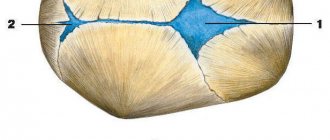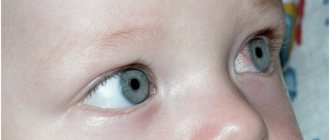A condition caused by the lack of effective gas exchange in the lungs immediately after birth is asphyxia (suffocation). If cardiac activity remains and other signs of live birth are present (spontaneous muscle movement, pulsation of the umbilical cord), the newborn is not able to breathe independently (or breathes rarely and shallowly). The frequency of birth of children with suffocation is 1 – 1.5%. From this article you will learn the main causes and degrees of this condition, as well as how medical care is provided for it.
Causes of newborn asphyxia
At the time of birth, the oxygen saturation of the blood entering the baby’s body is reduced, so that almost every newborn experiences a lack of oxygen. In some infants, rhythmic breathing does not begin on time and, due to insufficient alveolar gas exchange, the stabilization of basic blood constants is delayed.
According to various authors, asphyxia is diagnosed in 5 - 9% of infants.
Etiology of asphyxia
It occurs either in utero with insufficient oxygen supply to the fetus, or at birth as a result of respiratory distress, i.e., in both cases, with acute or subacute hypoxia and hypercapnia. Of leading importance in the development of fetal hypoxia are complications of pregnancy and childbirth (toxicosis, threat of miscarriage, premature rupture of amniotic fluid, placental abruption, etc.), which are caused by various diseases of the mother, as well as the influence of unfavorable exogenous factors on her. Thus, extragenital diseases (cardiovascular, pulmonary, renal failure, severe anemia), as a rule, are accompanied by hypoxemia of the pregnant woman and insufficient oxygen supply to the fetus.
With vegetative-vascular dystonia in pregnant women, manifested by arterial hypo- or hypertension, in stressful situations (exams, family conflicts), the blood supply to the fetus is disrupted and antenatal hypoxia develops. Hormonal dysfunction in the mother and previous medical abortions, as well as acute and chronic infectious diseases lead to placental insufficiency and inadequate oxygen supply to the fetus. Negative factors include smoking, drinking alcohol during pregnancy, and the age of the first-time mother (under 20 and over 30 years old).
Asphyxia of the respiratory tract can occur due to malformations of the fetus (pathology of the respiratory system, cardiovascular and nervous systems), as well as due to inhibition of the function of the respiratory center during drug anesthesia of labor.
Pathogenesis of newborn asphyxia
Chronic and acute hypoxia of the fetus and infant is accompanied by significant changes in the gas composition of the blood. The partial pressure of oxygen drops (P0 below 18 - 20 mm Hg), PCO increases (more than 50 mm Hg). Anaerobic glycolysis leads to the accumulation of acidic products and the development of metabolic acidosis along with respiratory. The blood pH value is below 7.2, the base deficiency is more than 11 mmol/l.
Hypoglycemia develops, and the synthesis of adenosine triphosphoric acid (ATP) decreases. Hyperkalemia is determined in the blood, and hypokalemia in erythrocytes. Plasma sodium levels decrease and intracellular edema develops. Biochemical studies indicate profound metabolic changes in tissues. These disorders can lead to delayed maturation, primarily of brain structures, including the centers of vital systems (respiration and circulation).
Under these conditions, for the affected fetus, the birth act may be an excessive burden and cause a breakdown of adaptation mechanisms, as a result of which the child cannot take his first breath and is born in a state of suffocation or attacks of suffocation occur in the early neonatal period (secondary asphyxia of the respiratory tract).
In response to intrauterine hypoxia, the fetus's heart rate increases and the anal sphincter relaxes (the amniotic fluid is stained with meconium). The respiratory center is irritated, and premature respiratory movements appear; aspiration of amniotic fluid, difficulty in the first breath and suffocation are possible.
Under the influence of hypoxia, hemodynamic disturbances occur, primarily in the microvasculature. The vessels lose their tone and become overfilled with blood, their permeability increases. The liquid part of the blood leaks into the surrounding tissues, swelling and dystrophic changes develop in the cells of all organs and systems.
Pathomorphology of newborn asphyxia
In children who died as a result of acute suffocation, pathomorphological changes are characterized by diffuse hemodynamic disorder and anoxia. Venous congestion of all tissues and organs, swelling of the brain and meninges, as well as small diapedetic hemorrhages are detected. In children born with suffocation and who lived for 2-3 days, degenerative changes are found in tissues, primarily in brain tissue. Severe degrees lead to the death of a large number of nerve cells.
Antenatal fetal death
Intrauterine fetal death is detected in 6% of multiple pregnancies. The likelihood of development depends on the number of fetuses and chorions. The greater the degree of multiple pregnancy, the higher the risk of death of one of the twins. In the presence of a common chorion, the probability of death of one of the fetuses increases several times compared to dichorionic twins. The immediate causes of antenatal fetal death are intrauterine growth retardation, placental abruption, severe gestosis, chorioamnionitis or the formation of an arteriovenous anastomosis with a common chorion.
The form of the pathology depends on the time of fetal death. In the early stages of pregnancy (up to 10 weeks), the “missing twin” phenomenon is observed. The dead embryo is rejected or absorbed. If there are two chorions, the death of one twin does not affect the development of the other. With a common chorion, the second twin increases the likelihood of cerebral palsy and intrauterine growth retardation. Antenatal fetal death in such cases often remains unrecognized and is regarded as a threat of termination of pregnancy.
If you die at the end of the first or beginning of the second trimester of pregnancy, the dead fetus does not disappear, but is mummified. It is compressed by the enlarging amniotic sac of a brother or sister, “dries out” and decreases in size. With a common chorion, the second twin often experiences congenital malformations caused by the entry of decay products into the body through the common circulatory system.
In case of multiple pregnancy and suspected antenatal fetal death, immediate hospitalization is indicated for examination and decision on pregnancy management tactics. During the examination, the gestational age and the number of chorions are determined, the condition of the living fetus is assessed, and somatic diseases and diseases of the mother’s reproductive system are identified. In case of general chorion and antenatal fetal death, diagnosed at the beginning of the second trimester, parents are advised to consider terminating the pregnancy due to the high risk of developing intrauterine pathology in the second twin.
At 25-34 weeks of gestation, a thorough examination of the surviving fetus (ultrasound, MRI) is necessary. If the condition of the fetus is satisfactory, prolongation of pregnancy is indicated. The need for urgent delivery in case of antenatal fetal death is determined taking into account the condition of the mother and surviving child, the likelihood of developing intrauterine disorders and the risk of complications caused by prematurity. Indications for delivery on the part of a pregnant woman include somatic diseases and diseases of the reproductive system that prevent the prolongation of pregnancy. Relative indications from the fetus are anemia, terminal blood flow and the threat of fetal death with arteriovenous anastomoses. Antenatal fetal death after 34 weeks of multiple pregnancy is considered as an absolute indication for delivery.
If there are two chorions, urgent delivery is usually not required. The patient is placed under constant monitoring, which includes daily monitoring of temperature, blood pressure, swelling and discharge, as well as regular tests to assess the condition of the blood coagulation system. The condition of the living fetus is assessed based on the results of Doppler measurements of uteroplacental blood flow, biometry and echography of the brain. After birth, an autopsy of the deceased twin is performed and the placenta is examined to identify the cause of antenatal fetal death.
White and blue asphyxia
Depending on the time of onset of hypoxia, suffocation can be divided into congenital and postnatal. According to clinical manifestations, blue and white are distinguished.
- With blue
: the skin and mucous membranes are cyanotic, heart sounds are distinct, the swallowing reflex is preserved, but other unconditioned reflexes are reduced. - With white
: the skin is pale, muscle tone is reduced, reflexes are absent. Heart sounds are muffled, arrhythmia is noted.
Cyanosis (blueness) of the skin indicates impaired tissue oxygenation. Appears when the amount of reduced hemoglobin in the blood exceeds 50%.
There are total cyanosis, which covers the entire surface of the body, and regional (local). Cyanosis around the mouth, in the area of the nasolabial triangle is called perioral, cyanosis of the tip of the nose, earlobes, lips, tip of the tongue, hands and feet is called acrocyanosis.
With asphyxia, cyanosis also occurs with damage to the central nervous system, with respiratory failure, with cardiovascular diseases, and changes in blood composition.
Factors associated with the risk of having a child and requiring medical support immediately after birth are divided into 2 groups - antenatal and intrapartum conditions. Antenatal factors include:
- diabetes mellitus in mother,
- pregnancy hypertension,
- chronic diseases of the mother (cardiovascular, thyroid, neurological, renal),
- anemia,
- bleeding in the 2nd – 3rd trimesters of pregnancy,
- maternal infections
- polyhydramnios,
- oligohydramnios,
- prematurity,
- post-maturity,
- multiple pregnancy,
- medications (lithium, magnesium preparations),
- mother's drug addiction
- mother's age is less than 16 and more than 35 years.
Intrapartum conditions that occur during labor include emergency cesarean section, forceps or vacuum extraction during labor, premature or precipitate labor, prolonged labor over 24 hours, fetal bradycardia, meconium-stained amniotic fluid, umbilical cord entanglement and prolapse, abruption and placenta previa.
Symptoms of asphyxia depend on the severity of hypoxia. With mild hypoxia, the child’s condition after birth is regarded as moderate. In the first minutes of life, the child is usually lethargic, spontaneous motor activity and reaction to examination are weak. Physiological reflexes are suppressed.
Degrees of asphyxia in newborns
The clinical picture of suffocation depends on the severity of hypoxia. Occurring during childbirth, it is conventionally divided into severe, moderate and mild.
Mild asphyxia
A mild degree is a short-term delay in inhalation and exhalation with the appearance of moderate cyanosis, for example, with slight aspiration of amniotic fluid. Eliminated after suction of mucus from the oropharynx or independently. Asphyxia of newborns on the Apgar scale - 6 - 7 points.
A mild degree is manifested by a change in heart rate up to 160 beats or more per minute with a transition from acceleration to deceleration. Tachycardia is detected. Heart sounds are muffled. Breathes arrhythmically after prolonged primary apnea. Short-term apneas are characteristic. The skin is cyanotic (blue). They quickly turn pink after oxygenation (humidified oxygen). During the first three days of life, infants experience:
- increased excitability,
- the appearance of tremor,
- irritated cry
- sleep disorders,
- frequent regurgitation,
- hyperesthesia.
Changes in the baby’s physiological reflexes and muscle tone vary from person to person. Tendon reflexes are increased. Disturbances in the functioning of the central nervous system are transient in nature and are a consequence of metabolic disorders and intracranial hypertension. The condition of children usually improves quickly and becomes satisfactory by 3–5 days of life.
Moderate asphyxia
Moderate suffocation - with mild hypoxia, the condition after birth is regarded as moderate. In the first minutes of life, the baby is usually lethargic, spontaneous motor activity and reaction to examination are weak. Physiological reflexes are suppressed. Choking of moderate severity is characterized by a disturbance in the rhythm of breathing, a decrease or increase in heart rate, and cyanosis of the skin. In this case, physiological reflexes can be reduced or enhanced, motor activity is increased: tremor of the chin or limbs is often observed, as well as muscle dystonia, mainly with a tendency to hypertonicity. Apgar score 5 points.
Severe asphyxia
Severe suffocation is characterized as follows: “Pulse at birth is less than 100 beats per minute, slowing, the skin is pale, the muscles are atonic. The Apgar score one minute after birth is 0 – 3 points.” “White” – the condition at birth is regarded as severe. Muscle tone and motor activity are low. The reaction to inspection and pain stimulation in this form of suffocation is sluggish. Physiological reflexes are often absent in the first hours of life, and the sucking reflex is weakened. The color of the skin is cyanotic-pale and returns to pink slowly. The oxygenation effect appears a few hours after birth. Heart sounds are muffled. Central nervous system disorders are manifested by flaccid coma syndrome and hypoexcitability. The condition of children improves very slowly and approaches satisfactory only by the seventh day of life or later.
As a rule, severe suffocation (asphyxia) occurs after prolonged ante- and intrapartum hypoxia. In this case, the central nervous system is primarily affected. There are violations of the integrity of the vascular wall, minor hemorrhages and even hematomas; cerebral edema develops. All its functions are inhibited, the nervous regulation of internal organs is disrupted, contributing, along with hemodynamic changes, to the development of somatic pathology.
At the time of examination, breathing is absent or severely difficult, the heartbeat is rare (less than 100 beats per minute), muscle tone is sharply reduced, physiological reflexes are not evoked, and the baby makes almost no movements. Sometimes with asphyxia, pathological eye symptoms (“floating” eyeballs, nystagmus) are detected, and there may be convulsions. The Apgar score does not exceed 4 points. Hemodynamic disorders are accompanied by a deterioration in the rheological properties of blood (increased viscosity, red blood cell aggregation), and a decrease in circulating blood volume. It is possible that hemorrhagic syndrome may intensify as a result of the development of disseminated intravascular coagulation.
The condition of children at birth can be very serious. The skin is pale with an earthy tint. Can't breathe on his own. The baby does not cry, does not respond to examination, and there is no reaction to painful stimulation. Areflexia, adynamia, and lack of muscle tone are characteristic. The reaction of the pupils to light is sluggish. Heart sounds are muffled. Bradycardia is pronounced. Blood pressure is not detectable or low. Breathing in the lungs (after resuscitation) is often weakened.
Resuscitation measures restore vital functions, but do not remove the baby from a serious condition. This necessitates intensive treatment of the child in the pathology department.
Asphyxia of newborns. Neonatal resuscitation
Asphyxia is a syndrome characterized by lack of breathing or
irregular or ineffective breathing movements at birth
child in the presence of cardiac activity (there may be a disorder
heart rate).
A child with no pulse, no breathing, no umbilical cord pulsation and no voluntary
muscle movements are considered stillborn and cannot be resuscitated.
According to various authors, asphyxia is diagnosed in 5 - 9% of newborns.
Asphyxia occurs in utero when there is insufficient oxygen supply to the
fetus or at birth as a result of respiratory distress in the newborn.
Highlight:
1. fetal asphyxia, which is divided into:
· antenatal
· intrapartum
2. asphyxia of the newborn, which is divided into:
· primary, when the newborn baby does not breathe independently after ligation of the umbilical cord
· secondary, which occurs in the subsequent hours and days of a newborn’s life and which can develop as a result of aspiration, pneumopathy, birth injury to the brain and spinal cord, congenital defects of the lungs, heart, and brain.
The basis of any asphyxia is a lack of oxygen in the blood (hypoxemia), tissues (hypoxia), the accumulation of carbon dioxide (hypercapnia) and other acidic metabolic products in the body, which leads to the development of metabolic acidosis.
Profound metabolic changes are observed in tissues, which leads to disruption of the functions of vital organs and systems.
Clinic.
The condition of the newborn after birth is assessed using the Apgar score at 1 and 5 minutes according to the 5 most important clinical signs:
1. heart rate
2. respiratory rate
3. muscle tone
4. reaction to a nasal catheter or reaction to irritation of the soles
5. skin color
The condition is assessed by the sum of points (maximum 2 points for each characteristic separately).
Healthy newborns have a score of 8-10 points.
There are 3 degrees of severity of asphyxia on the Apgar scale:
· light
medium severity
· heavy
With asphyxia of mild severity - normal breathing has not been established within the first minute after birth, but the heart rate is more than 100 beats per minute, muscle tone is reduced, there is a slight response to irritation of the soles, acrocyanosis.
Apgar score 6 – 7 points.
In case of asphyxia of moderate severity, in the first minutes of life the child is lethargic, spontaneous motor activity is observed, reactions to irritation of the soles are weak, physiological reflexes are suppressed, the cry is short, reluctant, and unemotional.
Breathing is rare and irregular.
The skin may be cyanotic, and quickly turns pink when given oxygen, but acrocyanosis often remains.
Heart rate less than 100 beats per minute.
Apgar score – 4 – 5 points.
In case of severe asphyxia, the pulse at birth is less than 100 beats per minute.
There is no breathing or it is difficult, rare, irregular.
Muscle tone and reactions to irritation of the soles are low or absent.
The skin is pale or cyanotic, its color is restored slowly.
Most physiological reflexes cannot be evoked.
Apgar score – 0 – 3 points.
Asphyxia of a newborn is a terminal condition that requires resuscitation measures.
Since 1994, American and Russian neonatologists have developed a protocol for primary resuscitation of a newborn, according to which the provision of emergency measures lasts 15–20 minutes (ours is 20 minutes).
Mandatory conditions for carrying out emergency measures:
1. 2 specialists work according to the protocol (artificial pulmonary ventilation (ALV) + indirect cardiac massage (CCM))
2. We begin to work with the prenatal, studying the anamnesis, predicting the birth of a child in asphyxia and preparing everything necessary:
Ø in the delivery room the door must be closed, air movement is not allowed,
Ø the temperature should be 240 so that the child does not become hypothermic (hypothermia enhances metabolic processes, thereby increasing the body’s need for oxygen)
Ø turn it on, check the installation of the radiant heat source, warm up the table for the child
Ø we prepare masks and an Ambu bag, a source of oxygen
Ø we prepare a cushion for the child’s shoulders and medicines
3. We begin assistance from the first seconds, we do not wait for an Apgar score based on 5 signs, but as a basis for assessing the condition of a newborn with asphyxia, we take 3 indicators - breathing, skin color, heart rate.
These indicators are assessed sequentially.
There are three laws of resuscitation:
1. urgently clear the airways (from mucus, meconium)
2. restore breathing
3. support blood circulation
Diagnosis of newborn asphyxia
With the development of suffocation, irregular breathing or the appearance of individual “sighs” against the background of regular breathing are first noted. If hypoxia is not stopped, then the baby stops breathing (primary apnea), after which he can resume it in the form of separate breaths or weak, irregular breathing. With continued hypoxia, a repeated deeper arrest occurs (secondary apnea), which significantly increases the risk of brain damage. Only positive pressure ventilation can bring a child out of secondary apnea. Asphyxia in a newborn is characterized by tachycardia or bradycardia (more than 180 or less than 12 contractions per minute, respectively), pallor of the skin, localized or widespread cyanosis.
Diagnosis of suffocation at birth is based on signs caused by low Apgar scores at 1 and 5 minutes.
- A score of 0–3 points indicates severe suffocation,
- 4 – 5 points – moderate severity,
- 6 – 7 points – easy.
Fast and effective primary resuscitation during choking can only be provided with equipment and well-trained, experienced personnel. During childbirth, the presence of at least one specialist is necessary who has the skills to perform mechanical ventilation using a bag and mask, endotracheal intubation, chest compressions, and knowledge of indications for the use of medications.
Help with asphyxia of newborns
Primary care for a newborn in the delivery room:
- The infant should be received in a warm swaddle, placed under a source of radiant heat;
- When providing assistance, it is necessary to empty the airways of contents;
- Carry out tactile stimulation by wiping the skin, performing soft (gentle) stroking of the torso, limbs or head;
- Primary care activities should take no more than 20 seconds.
Nursing process for newborn asphyxia
Assessment of the condition and the need for resuscitation measures are based on an assessment of parameters: breathing, heart rate, skin color.
Complications
: intracranial hemorrhage, pneumonia, atelectasis (collapse of alveoli) of the lungs, dysfunction of internal organs.
Consequences
: in 20-30% of children, the consequences of moderate and severe asphyxia are manifested by encephalopathy, delayed physical and mental development, and movement disorders.
Forecast
: the baby’s condition depends on the cause of suffocation and the severity of the latter. More often than not, this is done with great care. With modern care and methods of staged treatment, after severe suffocation during childbirth, severe and moderate encephalopathy subsequently develops in 20–30% of children.
In acute suffocation, lasting 5-15 minutes, predominantly reversible functional disorders develop. However, due to even mild intrapartum suffocation, 12–20% of children discharged from the maternity hospital healthy subsequently exhibit various symptoms of damage to the central nervous system.
In most cases, after severe prolonged suffocation, irreversible destructive changes in tissues develop, which can lead to serious consequences in the form of delayed physical and mental development and movement disorders. Asphyxia in newborns can cause life-threatening complications such as intracranial hemorrhage, aspiration pneumonia, pulmonary atelectasis, or persistent dysfunction of internal organs and systems.
Fetal asphyxia, the danger of pathology and the causes of its occurrence
A woman carrying a baby dreams of only one thing - for the baby to be born healthy. However, conditions that threaten the life and health of a child cannot always be prevented.
One of the complex pathologies that occurs during pregnancy is fetal asphyxia. Translated from Greek, the word “sphygmus” means “pulsation”, and the preceding “a” means negation.
What symptoms indicate this condition, why it is dangerous and what are the causes of intrauterine fetal asphyxia, you will learn in the article.
What is fetal asphyxia?
When the baby is in the mother's tummy, he receives oxygen through the placenta, or, more precisely, through the umbilical cord extending from it.
It is thanks to the placenta and umbilical cord that gas exchange occurs in the baby’s cells and tissues, and after enriching the tissues with oxygen, carbon dioxide is removed. The waste gas leaves the mother's body with exhalation.
Once born, the baby takes his first breath and will continue to breathe on his own.
If the gas exchange process is disrupted, the child does not receive enough oxygen, the concentration of carbon dioxide in his blood increases, and the heart rate becomes disrupted.
Impaired functioning of the child’s heart is one of the most basic signs of fetal asphyxia. Therefore, doctors closely monitor the heart of the unborn baby.
Having discovered something wrong in the sound of the heart sounds, the gynecologist may suspect the onset of intrauterine asphyxia of the fetus and take timely measures.
What causes fetal asphyxia?
The most common cause of fetal asphyxia is a violation of blood circulation in the placenta and its obstructed flow to the baby.
If the cause of asphyxia is compression, knots, or entanglement of the umbilical cord, in addition to stopping the blood flow in the vessels, venous stagnation of blood may occur in the child’s brain.
If the cause of asphyxia is placental insufficiency, the pathology is called antenatal asphyxia.
Pathology can occur due to various diseases of the expectant mother, including infectious ones. Toxicosis in a woman, which occurs in a severe form, can also provoke this problem, because in this case the child does not receive enough nutrients and oxygen for a long time.
Learn how blood is taken from a vein from a newborn.
You can read how Klebsiella is dangerous for babies here.
Any conditions in a woman’s body that lead to oxygen starvation in her can cause asphyxia in her baby.
Convulsive contractions can lead to deterioration of placental blood circulation during childbirth - these are very frequent contractions with practically no interval.
Also, the pathology can be caused by difficult childbirth, for example, if a woman has a narrow pelvis or the child is in an incorrect position - facial presentation.
Another factor that provokes the development of asphyxia is the entry of mucus or amniotic fluid into the child’s respiratory tract. In this case, the child will develop pathology after birth.
How dangerous is asphyxia?
If asphyxia is short-lived, the child may develop compensatory reactions, such as a decrease in tissue oxygen consumption and increased blood circulation.
With a lack of oxygen, metabolic processes are disrupted, acidic products accumulate in the child’s body, and disruptions in the acid-base balance occur—acidosis. Because of this, all organs and systems of the baby suffer.
If asphyxia is prolonged and severe, intracerebral hemorrhages, cardiac dysfunction, and neurodevelopmental problems may occur.
https://youtu.be/HovE47ccUGI
In cases where treatment is not carried out, changes in the baby’s body can become irreversible, which will lead to his death. This pathology is one of the causes of stillbirth. Children who survive may have problems with vital organs.
How to recognize pathology?
Instrumental and laboratory research methods help diagnose pathology during intrauterine development. The most obvious sign of asphyxia is an abnormal heart rhythm of the child. It is detected by auscultation - listening to sounds using a stethoscope or phonendoscope.
Having noticed disturbances in the functioning of the heart, to clarify the picture, the doctor refers the pregnant woman to phonoelectrocardiography. The study allows you to reliably determine the heart rate, detect murmurs, and muffled heart sounds.
The study is carried out as follows: the woman lies on her side, this position allows to avoid squeezing the inferior vena cava. Electrodes are placed on the pregnant woman's right thigh and stomach, and a microphone is placed in the place where the baby's heartbeat is most clearly heard. The diagnostic procedure lasts no more than 5 minutes.
Depending on the stage of asphyxia, symptoms may be as follows:
- at the initial stage, rapid (up to 160 beats) or slow heart sounds, increased activity of the child, expressed in his intense movements, may be observed;
- the average degree is characterized by a slowdown in heart sounds to one hundred beats per minute, they become muffled, but remain rhythmic, the woman can feel painful tremors of the fetus;
- in severe cases of pathology, a sharp slowdown or acceleration of heart sounds occurs, their arrhythmia is observed, the child’s motor activity slows down and then stops altogether.
Due to lack of oxygen, meconium (original feces) mixes with the amniotic fluid. If it enters the respiratory tract, the child may develop pneumonia.
At any stage of development of the pathology, it is diagnosed by the child’s behavior, that is, the strength and nature of his movements, heart rate and the nature of the amniotic fluid.
If a child is born with first degree asphyxia, he has weak and shallow breathing, the skin may have a bluish tint, but this phenomenon is weakly expressed. These symptoms go away on their own within a short period of time.
A baby born with a moderate degree of pathology has a bluish tint to the skin and does not breathe due to amniotic fluid entering the respiratory tract. Heart rate is slow. In this situation, emergency measures are taken.
In severe cases of pathology, the newborn has pale skin, the oral mucosa and tongue are white, there is no breathing, and the heart rate is sharply increased or, on the contrary, slowed down. At this stage of asphyxia, it is possible to revive the child in rare cases.
Find out what a UTI is in a child.
You can find out how much urine a child needs for analysis here.
Let's decipher the baby's blood test: //moeditya.com/pediatriya/analizy/analiz-krovi-norma-u-detey.
Treatment of fetal asphyxia
For intrauterine asphyxia, therapy is aimed at eliminating the causes of its development. For example, if the pathology is provoked by convulsive contractions, drugs are used that reduce uterine contractions.
The following methods are used to eliminate pathology:
- the woman is allowed to breathe oxygen for 10 minutes, a 5-minute interval is made, the procedure is repeated until the child’s heart tones equalize;
- glucose and ascorbic acid are administered intravenously;
- it is possible to take an aqueous solution of glucose orally;
- Corazol is administered intramuscularly or intravenously;
- Intravenous administration of sigetin is effective.
If the desired effect of therapy is not observed, given that a disorder such as fetal asphyxia can lead to the death of the child, emergency delivery is performed. Depending on the situation, abdominal forceps may be used, and in rare cases a caesarean section is performed.
To revive the child, the following activities are carried out:
- the umbilical cord is not cut while there is pulsation in it;
- the child is placed in a bath with warm water to avoid hypothermia;
- using a special spray, the upper respiratory tract is cleared of mucus;
- Cardiazol is administered to improve the child's heartbeat.
When the baby begins to cry, his breathing and heartbeat return to normal, the baby is separated from the mother.
It is worth understanding that fetal asphyxia is a pathology that can be prevented by promptly eliminating the causes that provoke its development. An important role in this is played by the treatment of infectious diseases that arise in a pregnant woman and the fight against toxicosis. Rational management of childbirth is of great importance.
Source: https://moeditya.com/pregnancy/bolezni-pri-beremennosti/asfiksiya-ploda











